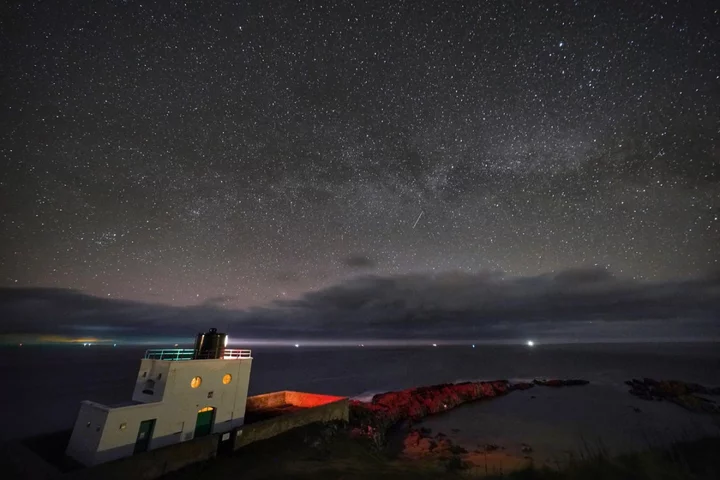
Paris police shoot woman at station after threats
The woman, who was reportedly heard making threats to blow herself up, is in critical condition.
2023-10-31 19:29

Cornell University boosts security after antisemitic threats
The FBI has been alerted over online posts that used slurs about Jewish students at the New York college.
2023-10-31 05:16

Is Zach LaVine playing tonight? Latest injury update for Bulls vs. Pacers
Zach LaVine just posted a career-high against the Detroit Pistons, will he continue his scoring spree against the Pacers?
2023-10-31 02:24

Tommy Pham sets record straight on pinch-hit that kept him from setting a record
The Arizona Diamondbacks subbed Tommy Pham out of Game 2 of the World Series when he had the chance to go 5-for-5. The DH explained why on Instagram.
2023-10-30 02:51

Infrared ‘aurora’ like northern lights spotted on Uranus could help find alien life, scientists say
Scientists have spotted an infrared aurora on Uranus that could help us find alien life. On Earth, aurorae are best known in the form of the northern lights, when bright light streaks across the sky. Uranus also has its own aurora – though it is not visible in the same way, because of the different atmosphere on that planet. Researchers have known about ultraviolet aurorae on Uranus since 1986. But now scientists have confirmed there are infrared aurorae on the distant planet, too. Scientists hope that the findings could help explain the magnetic fields of other planets in our solar system. And it could help us find out whether distant planets support alien life. Aurorae happen when charged particles arrive at a planet and hit its atmosphere, brought down through its magnetic field lines. To better understand those on Uranus, researchers analysed the light from the planet and watched for a specific charged particle that changes brightness depending on how how it is and how dense the atmosphere is, so that it can be used as a thermometer. The researchers found that the density of that particle significantly increased, which suggests they are being ionised by an infrared aurorae, they say. Scientists hope that will inform our understanding of other, similar planets, as well as which worlds might be suitable for alien life. “The temperature of all the gas giant planets, including Uranus, are hundreds of degrees Kelvin/Celsius above what models predict if only warmed by the sun, leaving us with the big question of how these planets are so much hotter than expected? One theory suggests the energetic aurora is the cause of this, which generates and pushes heat from the aurora down towards the magnetic equator,” said Emma Thomas from the University of Leicester, who was lead author on the new study. “A majority of exoplanets discovered so far fall in the sub-Neptune category, and hence are physically similar to Neptune and Uranus in size. This may also mean similar magnetic and atmospheric characteristics too. By analysing Uranus’s aurora which directly connects to both the planet’s magnetic field and atmosphere, we can make predictions about the atmospheres and magnetic fields of these worlds and hence their suitability for life. “This paper is the culmination of 30 years of auroral study at Uranus, which has finally revealed the infrared aurora and begun a new age of aurora investigations at the planet. Our results will go on to broaden our knowledge of ice giant auroras and strengthen our understanding of planetary magnetic fields in our solar system, at exoplanets and even our own planet.” The findings might also help explain a mysterious phenomenon on Earth known as geomagnetic reversal, where the north and south pole switch around. Scientists still know very little about that rare phenomenon, and how it might affect things such as satellites and communications. That process happens every day on Uranus, however. Researchers hope they can use its aurorae to get better data on the nature of that reversal – and what might happen if Earth has one, too. The findings are described in a new paper, ‘Detection of the infrared aurora at Uranus with Keck-NIRSPEC’, published in Nature Astronomy. Read More People don’t know their Uranus from Eridanus when it comes to astronomy Scientists find surprise ‘layer’ underneath surface of Mars Scientists see huge explosion in space – and it could explain life
2023-10-28 00:46

Putin aims to have Russian space station by 2027
President Vladimir Putin said on Thursday the first segment of Russia's new orbital station, which Moscow sees as
2023-10-27 07:50

A'ja Wilson proved herself to be the best player in the WNBA
A’ja Wilson's performance propelled the Las Vegas Aces to repeat as WNBA champions, confirming her status as the league's best player.
2023-10-27 01:56

Jonathan Majors' accuser arrested in New York, won't be prosecuted
The woman who accused actor Jonathan Majors of assaulting her during a dispute in March was arrested Wednesday night on suspicion of assault and criminal mischief related to the same incident, according to a source with knowledge of the matter.
2023-10-27 00:52

Judge fines Trump $10,000 for violating gag order
The judge had issued a gag order previously to stop Mr Trump from speaking about court staff.
2023-10-26 04:45

Fireworks in court as Trump team calls ex-lawyer Michael Cohen a liar
Lawyers for Donald Trump tied to undermine Michael Cohen's credibility during high-stakes fraud case.
2023-10-26 04:20

Scientists make the biggest simulation of our cosmos ever, with the mass of 300 billion galaxies
Scientists have created what they say is the biggest simulation of our cosmos ever. The virtual universe has the mass of 300 billion galaxies, packed into a space with edges ten billion light years across. Scientists hope that it will help tell us how the real universe that surrounds us first evolved. They could also help address problems in our understanding of physics that currently suggest we might have made deep mistakes about the cosmos. But the first results from the simulation suggest that it might not work: the findings do not get rid of the tensions between different observations about the universe that have proven so difficult to scientists. Researchers created the simulation, named FLAMINGO, by taking the vast amount of data that has been gathered by telescopes such as Nasa’s JWST and other projects. Those projects give information about galaxies, stars and the other arrangement of matter in our cosmos, which can then be fed into the computer. Researchers then hope that the computer can use that data to simulate the evolution and nature of our universe. That can then help resolve those fundamental difficulties we currently face in physics. One of those issues come from the current theory that the properties of our universe are decided by only a few “cosmological parameters”. We can measure those parameters very precisely. But scientists have run into issues because those parameters do not always match. For instance, there are multiple ways of measuring the Hubble constant, or the speed at which the universe is expanding – but those multiple ways show different results, and scientists have not been able to explain them. Scientists hope that the simulation can help explain or resolve that tension. But it is yet to do so. That is just one of the many ways that the creators of the FLAMINGO simulations hope that they can be used to better understand the universe and the observations that we have of it. It might also allow us to make new kinds of discoveries: the vast amount of data means that it can construct random, virtual universes and see how theories work in there, for instance. The work is described in three papers, all of which are published in the Monthly Notices of the Royal Astronomical Society today. Read More Scientists see huge explosion in space – and it could explain life Massive space explosion observed creating elements needed for life Tim Peake: Possibility of all-UK space mission a ‘very exciting development’
2023-10-26 01:50

Jonathan Majors assault case will move forward to trial
A New York judge on Wednesday denied a motion to dismiss the assault case against actor Jonathan Majors, moving the case forward to trial.
2023-10-26 01:17
